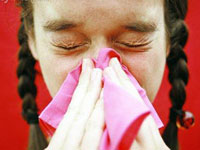Antibiotics do not cure routine sinus infections
Routine sinus infections are not really helped by antibiotics and other medicine that is often prescribed, researchers suggest.

In the British study, people suffering from facial pain and a runny nose with greenish or yellowish mucous generally improved within about two weeks - whether they took the standard antibiotic amoxicillin, steroid nose spray or fake medicine.
The results, based on patients' reporting whether their symptoms had improved, echo previous findings in children.
Antibiotics, particularly the penicillin-like drug amoxicillin, are among the most commonly prescribed medicines for sinus infections.
Steroid sprays sometimes are used, but the study found they also were no better than dummy drugs, although they appeared to provide some relief for patients with only minor symptoms.
The study should lead to a "reconsideration of antibiotic use for acute sinusitis. The current view that antibiotics are effective can now be challenged, particularly for the routine cases which physicians treat," said lead author Dr. Ian Williamson of the University of Southampton in England.
"Physicians can focus on effective remedies that improve symptom control," which include ibuprofen and other over-the-counter painkillers, Williamson said.
Inhaling steam and squirting salt water into the nose to flush out thick mucous are among other methods that sometimes provide relief, he said.
The study appears in Wednesday's Journal of the American Medical Association.
Researchers randomly assigned 240 adults to receive one of four treatments: 500 milligrams of amoxicillin three times daily for seven days and 400 units of steroid spray for 10 days; only amoxicillin; only steroid spray; or fake medicine.
Patients on the drugs did not get better quicker than those using the placebo.
Sinus infections are diagnosed in about 31 million Americans each year and are among the most common reasons for doctor visits. In the United Kingdom, primary care doctors see 50 or more cases a year, the study authors said.
The infections affect air spaces called sinuses around the nose and in the lower forehead. Inflammation and excess mucous can cause nose congestion, headaches and eye and face pain. Causes include bacteria, viruses, fungal infections and allergies.
Despite a long-held notion, recent studies have found that yellowish or greenish mucous does not always mean the infections are bacterial, said Dr. Vincenza Snow, a Philadelphia internist and director of clinical programs and quality of care at the American College of Physicians.
Moreover, while antibiotics are designed to treat bacteria, these drugs are not always very effective at treating bacterial sinus infections because the medicine has a tough time reaching the sinuses, she said.
The U.S. physicians' group issued guidelines in 2001 advising against using antibiotics for most sinus infections in otherwise healthy people, blaming overuse for contributing to the growing problem of bacteria resistant to drugs.
The group is considering updating the guidelines to say recent evidence reaffirms the drugs "don't really change the course of the illness," Snow said.
Dr. Marvin Fried, otolaryngology chairman at Montefiore Medical Center in New York, questioned whether all the patients in the study had true sinus infections. While patients were recruited by family doctors, the results were based on patients' self-reported symptoms rather than medical exams, he noted.
Still, Fried said the conclusions are in line with September guidelines from a group of head and neck doctors, whose treatment options included observation without antibiotics for mild sinus infections.
Subscribe to Pravda.Ru Telegram channel, Facebook, RSS!





